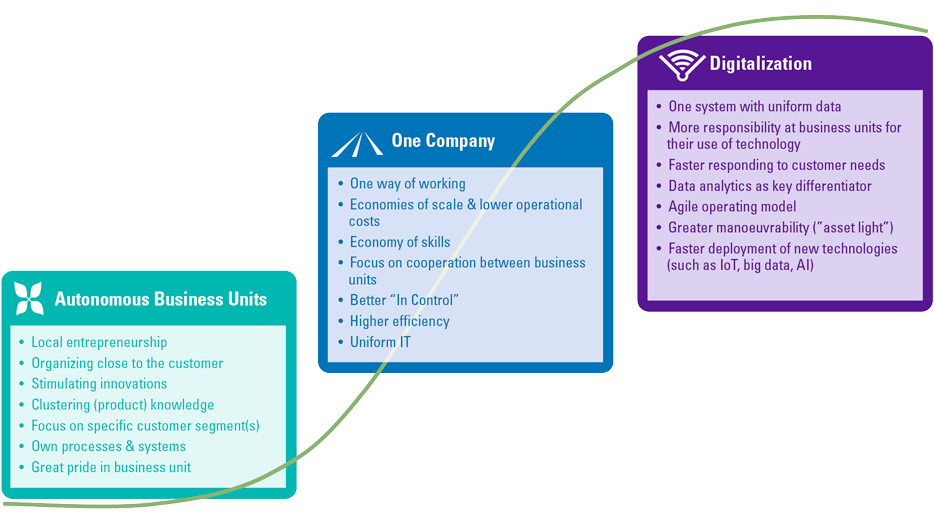“One Company” transformations are increasingly seen as a condition for digitalization. The harmonization and simplification of the operating model that result from this digitalization, enable organizations to accelerate and become more agile. If they fail to respond quickly to the changing environment and customer expectations, they risk losing relevance. In this article, we explore the drivers behind “One Company” in a digital world and provide the approach and the lessons learned of some organizations that have preceded your organization.
Introduction
Through digitalization, managers pursue a more decisive organization that can respond quickly and flexibly to growth opportunities and that can react to new challenges. From KPMG’s annual global CEO Outlook survey, it has been clear for many years that this importance is widely recognized. It is no surprise that this interest has only grown due to COVID and that the ambitions have been accelerated ([KPMG21]).
Now that digital transformation is prioritized in many organizations, we increasingly notice that “One Company” is an important condition for digitalization. Based upon “One Company” principles, an organization can respond faster to changing circumstances. This leads to direct benefits and provides a solid contribution to the effectiveness of customer-driven and data-driven organizations. In this article we explore the approaches for a “One Company” transformation based on a few cases and explore how “One Company” digitalization can help accelerate this.
The step towards “One Company”
In the past decade, many large companies have begun the transformation to “One Company”. Organizations were largely organized in semi-autonomous units with a responsibility for a certain geographic region or a specific product market combination. This decentral system that usually emerged organically from past takeovers, has many advantages. The structure stimulates local entrepreneurship and is highly suitable to be close to the customer. Furthermore, this model works especially well in times of growth and expansion. And the successes and return per business unit can be assessed relatively easy. The decentral model gives local management a lot of freedom. The differences between the units are usually great, and prompted by different customer requirements, specific circumstances in certain countries or customer segments, but also by the wishes and preferences of local management.
We noticed in the past decade that organizations also paid more attention to the disadvantages of a – possibly over-implemented – decentralization. In the decentral model, business units experience less added value of being part of a group. Also, Boards of Directors and Supervisory Boards wonder whether this governance set-up with multiple similar processes and multiple systems is both efficient and effective. According to them, concepts such as economies of scale and synergy are not given sufficient content. It is against that background that in the past decade organizations under the heading of “One Company” have focused on adapting the model with more reasoning based on a joint uniform customer approach and efficiency of standardized processes. Examples are Achmea, DSM, Friesland Campina, ING, National Police, PostNL, Triodos and many other organizations.
After taking the step of autonomous business units towards a “One Company” model, we now see organizations taking the next step towards further acceleration of digitalization based on “One Company”. Digitalization therefore seems to be the next step after the (initial) step from autonomous business units to “One Company”. “One Company” can make an important contribution to this, in addition to the aforementioned synergy benefits.
Figure 1. The development of “One Company”. [Click on the image for a larger image]
“One Company” takes care of harmonization and simplification
“One Company” can make an important contribution to the preparation of the organization to digitalization and the agile procedure. Simply put: the “One Company vision starts with the dream of having one system with standardization of business processes across the entire organization ([Koot14a]). This has always had a certain appeal because of the intended benefits:
- Lower maintenance costs;
- Effortless exchange of information between business units;
- Easier aggregation of management information on clientele, products, et cetera;
- Easier exchange of staff;
- Better compliance and (cyber)security design;
- Less dependence on scarce staff.
In practice, however, this requires much more than a sole standardization of the IT landscape; it requires the harmonization of the entire operating model of the organization:
- Management of the organization, the operating, and the business model;
- Practices and processes;
- Design of the IT environment;
- Screens, letters, e-mails, and reports of the system;
- Standardization of master data;
- Internal controls;
- Performance indicators ;
- Prioritizing of (strategic) projects.
These are all major organizational issues. Especially in larger organizations with multiple semi-automatic units (business units) that are responsible for their own performance, differences emerge rapidly, driven by market orientation and flexibility towards the local market. These historically grown and maintained differences often determine the design of a fragmented IT landscape. In it, four variants are recognized ranging from highly isolated to common processes; these alternative IT governance models are included in Figure 2.
Figure 2. Alternative IT governance models ([Ross06]). [Click on the image for a larger image]
Strategy for harmonization
In abstract, the benefits of harmonization are often quite clear. However, realizing these benefits is not easy. Most business units must partially give up their freedom and adapt to more uniform practices and standards. Not being able to determine your own priorities in all areas has a major impact and leads to resistance. Managing this resistance is an important assignment in realizing a “One Company” organization model. Many Boards of Directors will have to assess the need for change and support among the major stakeholders. It is not easy to push such a substantial change if the conditions for implementation are insufficient. A proper assessment of the situation in the market should guide the approach and speed of change ([Wije94]). In summary, only under high pressure does everything become sufficiently liquified for a top-down approach.
Approaches for harmonization
Most organizations start with strategic conversations about the need for change and the conditions for implementation. This conversation mainly takes place at the level of the board of directors and/or the supervisory board. Sometimes this leads to an analysis on a component, such as IT, or an entire strategic reorientation.
From conversations with various organizations that have implemented “One Company”, five typologies of approaches emerge before starting the change (see Figure 3):
- big bang with new blueprint and (partial) new management;
- harmonization of procedure and IT per business unit;
- standardization of staff functions/positions;
- convergence strategy;
- emphasis on collaboration.
Figure 3. Approaches for implementation of “One Company”. [Click on the image for a larger image]
These approaches are described in more detail below.
1. Big bang with new blueprint and (partial) new management
The big bang implementation of “One Company” is an extreme remedy that is only used by organizations in exceptional cases. The need for change must be extremely high, with the top of the organization being prepared to redesign a new organization model and even to replace part of the management. This occurs with, amongst others, mergers and acquisitions or a substantial external impulse, often under the leadership of a new chairman.
One of the best-known examples of the design of a “One Company” in the Netherlands probably is the design of the National Police. With the political decision to form the National Police, one corps was established instead of 26 regional corpses. The formation of a single organization aimed to improve police performance and quality, increase efficiency and reduce overhead. This reorganization was strongly driven by the Ministry of Justice and Security, starting with the appointment of a new top structure. The new (corps) leadership has started to draw up a new program plan, followed by a draft plan that described the mission, vision, strategy and its impact on culture, behavior, and leadership, as well as a high-level description of processes, future structure, and the management of the new organization. This was further detailed in so-called Implementation and Realization plans ([KNP12]).
The centralization of ICT management – through which processes and systems could be harmonized – was one of the results, although less emphasized. Eventually, a Politie Diensten Centrum (PDC, Police Service Center) was also formed as a shared service center for support services: Finance, HRM, Facility services, Purchase, Communication, and ICT ([Veef20]). Such a reorganization does require a decisive leader with a strong vision and a clear mandate.
Similar conditions can be seen in restructuring and acquisitions. There, too, it is often necessary to introduce a new model (in a short period of time) in order to achieve the intended goals. Here, designing a “One Company” organization is one of the common concepts of synergy.
2. Harmonization of procedure/method of working and IT per business unit
It is common practice that managers consider IT as a major area for synergy, also because investments in and costs of IT are relatively large. Many organizations are facing scarcity of competences and capacity in this area, especially with respect to the implementation of new technologies, such as big data of Internet of Things. The need for a “One Company” solution therefore seems obvious.
Although “One Company” is of course no IT issue, synergy can be achieved across the axis of IT. In the past, many organizations have established their uniqueness by setting up specific (customized) IT solutions and by convincing their environment that this was strategically necessary. Therefore, the distinctiveness was often in products and services, including IT support. In recent years we have experienced that suppliers of (ERP) software are increasingly offering full functionality in combination with other solutions and that they limit customization and even make it impossible, partly because of the increasing cloud or SaaS strategy. This enables IT to increasingly harmonize across business units. This often involves developing a template for designing IT, processes, data and organization, which is then rolled out by business unit. In addition, the template is periodically enriched with any new (internal) best practices. We notice that a distinction is made between:
- global solutions for the entire company;
- modular solutions for specific regions or components;
- unique solutions for a specific business function.
Even in such a scenario, harmonization remains a complex issue, despite the fact that many organizations have gained experience with ERP implementations in recent decades.
3. Standardization of staff positions
In organizations that have a great need for change, but in which the (pre) conditions for implementation are only met to a limited extent, usually start by centralizing staff positions (HR, Finance, Procurement, Facility services, et cetera). This not only requires standardization of processes, but also of the associated IT. This is often seen as a first step towards further harmonization. Two approaches can be distinguished:
- standardize procedures and IT across the group;
- “lift & shift” and then optimize.
It is important to realize that this is no walk in the park, it really is a transformation that demands attention and perseverance for a longer period of time.
One of the organizations that has chosen this path is DSM. DSM has been using both mentioned approaches and around 2000, it took the first step towards “One Company”. This step was the standardization of a single e-mail system on one global network ([Hoev06]), which created the technical basis upon which further harmonization could take place. After that, the standardization of business processes started and mainly focused on the order-to-cash-processes.
Finance, Purchasing, and even Maintenance followed. Finance was accommodated in a Shared Service Center through a lift & shift approach, after which it was standardized even further. The reason for this was that standardizing first and then centralizing would take too long. In the case of Purchasing, indirect purchasing has been standardized using one purchasing organization that works according to one process.
At DSM it became clear that a “one-size-fits-all” approach would not always be feasible. Because of the different markets in which DSM is active, it was essential to differentiate for the various divisions. For DSM, the business value of “One Company” lies not only in the lower costs resulting from harmonization, but also in the ability to implement policy more quickly and to integrate and disentangle business units more quickly in the event of takeovers or when parts of the business need to be sold.
Important in this scenario (but also in other scenarios) is to ensure that harmonization is implemented in all aspects. In this strategy the focus is on harmonizing processes and IT. Without the correct translation into what this means for governance and data within the organization and its business units, it is almost impossible to be successful in this manner. Choosing this route means that managers need to pay sufficient attention to it.
Figure 4. Harmonization & simplification of processes & IT is only possible if these assumptions have also been enforced in data, governance, and strategy. [Click on the image for a larger image]
4. Convergence strategy
A convergence strategy can be applied to organizations where the necessity is largely acknowledged, but not yet widely supported, and where the conditions for implementation are scarce. This means that a sharp vision and blueprint are being developed for the future situation and that all investments are compared with this vision. The organization will therefore gradually reach a large degree of harmonization and standardization. This takes many years of implementation, however. This convergence strategy is applicable to supporting and primary business processes.
The power of the convergence strategy is that it is a clear movement, in which successes can be shown year after year. And as it occurs gradually, the organization has time to adapt and realize the required competence development. After a while, both management and staff members will notice that it works and that they too will see more similarities and possibilities to cooperate and harmonize than differences. You could say that the movement to One Company becomes the organization’s DNA.
The journey cannot be planned for one hundred percent. An organization-wide transformation is at stake that involves multiple business units, each with their own market dynamics, technological developments and local context with legislation and regulation. A convergence strategy is a sound approach for a so-called plateau-by-platform approach; for example, by taking the next step in consecutive strategy cycles and multi-annual plans. Here, harmonization can also serve multiple purposes, such as cost reduction, improving customer service or increasing competitiveness by shortening the time-to-market of new products and services.
The convergence strategy works gradually, although it is supported by a clear direction and sequence. An important design question concerns the design, the implementation, and the execution of processes. The dialogue about the current and the desired degree of harmonization per key business process provides significant insight and ensures a clear dot on the horizon (see Figure 5). Subsequently, this helps in the determining what is needed in the area of IT solutions, data, control and possibly even the product and services portfolio. And in what order steps can be taken.
Figure 5. Mapping of the degree of (desired) harmonization per process as “compass” for transformation. [Click on the image for a larger image]
5. Emphasis on cooperation
Not all organizations that have a latent need to harmonize, offer the possibility for strong harmonization. And it might not fit in with the culture at that moment. Harmonization is then mainly realized by focusing on governance and possibilities for cooperation. Usually, the obvious areas (low-hanging fruit) are first addressed in order to define joint solutions and temporary governance groups, or committees are set up to enable this harmonization. Over time, most low-hanging fruit will have been picked up and the Board of Directors will have to provide an additional incentive for any further desired harmonization. Of course, one of the abovementioned directions can be addressed, such as convergence, centralization of staff positions, etc.
An organization who has done this successfully is Triodos. Triodos has a strong culture based upon common vision and core values (sustainability, transparency, excellence, and entrepreneurship) ([Trio20]). Within this culture, the various business units have always operated relatively autonomously. In recent years, Triodos has experienced massive growth. The need for increased digitalization has led to the further development of a “One Bank” strategy, based on cooperation and the organization of an “agile way of working” ([Kron19]).
“One Company” and digitalization
The theme of harmonization has been a topic of conversation at the management table for ages. “One Company” is therefore not new at all. However, what has changed is the tone of the conversation. Through digitalization, the need is becoming stronger and (regularly) seen as essential for the continued existence of the organization. The following factors play a role:
- Customer expectations: “Standing still is going backwards”
Customers live in a digital world and have (high) expectations that they bring along in every interaction with organizations. The level of service, in terms of convenience, supply, personalization, privacy, and security, that is considered self-evident grows with the experiences that are gained in various sectors ([KPMG20], [Ross19]). Start-ups, FinTechs and other digital-first or digital-only players, often have a head start to existing organizations or can exploit specific benefits. A digital world also makes it easier for customers to switch (even with a single mouse-click), and the network effects then make it increasingly difficult to keep up to date. Think of the quote from Ernest Hemingway’s book The Sun Also Rises: “How did you go bankrupt? Two ways. Gradually, then suddenly.” - Range of solutions: “Do not reinvent the wheel”
The availability of standard solutions, such as SaaS applications and low code platforms in which best practices are processed, has ensured that an organization can hardly distinguish itself in this area anymore. Wide adoption of such a platform then provides a cost-efficient way to enduringly comply with best practice, investing energy in the aspects in which the organization can distinguish itself. The key question then becomes in which area you can really distinguish yourself as an organization, revealing the degrees of freedom of the business units. - Adoption speed of new technology: “Increase ROI for innovation”
New technologies often offer promising applications of cost reduction, more effective customer service or even new propositions and business models. Think for example of the use of an IoT for preventive maintenance or the possibilities that IoT offers for a power tool producer as Hilti to offer its products “as-a-service” in addition to unit sales. The rapid and effective deployment and adoption of new technology are enabled in a “One Company” environment. As a result, it becomes easier to find the right use cases organization-wide, to build up capabilities and, if successful, to accelerate further adoption. This also realizes the business case at a faster pace.
Consequently, we have seen in recent years that organizations are further drawn towards harmonization through digitalization. Digitalization facilitates harmonization because new technological possibilities reduce the disadvantages of harmonization. This enables organizations to have a large, simplified core surrounded by the required differentiation towards specific businesses or customer groups. This approach makes it possible to have the benefits of a common, generic basis and the specific advantages of a certain degree of differentiation.
Due to the rapid spread of “industry best practices”, differentiation in processes never provides an everlasting competitive advantage. At the same time, the artificial standardization of processes that do contain important (local) differences, could lead to negative side effects and competitive disadvantage. Therefore, the optimal level of standardization is where solely differentiation takes place that is directly linked or retraceable to inherent differences in business models or in geographical locations between business units. The implication is that all other differentiation that has “historically” emerged can be considered “waste” and should therefore be eliminated.
Key learning points from practice
In many large organizations with “One IT”, substantial IT cost savings can be realized, which also offer more room for digitalization. Key learning points from practice are:
- Harmonizing processes, practices and IT always leads to resistance at certain levels. Dealing with this adequately requires strong leadership and a clear ambition. Ensure a clear focus and prioritization. The key to success is to focus on business goals and desires, coherently shaping governance, organization, processes, data, and IT design.
- Do realize in advance that the implementation of “One Company” is a major change that takes a number of years and hardly ever occurs without some turmoil. In a number of cases mentioned, we have seen that there is always a moment when the chosen direction is doubted. Staying on course will, in many cases, determine ultimate success. After this “tipping point”, implementation usually becomes easier.
- Clearly define which components of the harmonized application landscape are mandatory and part of the core and determine the degrees of freedom for business units for their own process, data, and IT design.
- Ensure in the organization of processes and the application landscape that customer experience and innovation are paramount so that changing customer needs can be quickly responded to. Only this way, can the “One Company” concept offer everlasting benefit (“experience centricity by design”).
- To accelerate, many organizations nowadays turn to (scaled) agile methods to organize change. This new way of organizing often already provides a significant advantage by reducing overhead, faster decision-making, more predictable delivery, and more focus on delivering business value.
Conclusion
In recent decades, many organizations have been dominated by harmonization and organizing a “One Company”. Frontrunners now use this harmonization to shift their attention from rethinking processes and transactions to using data and digitalization. Harmonization has become a condition for being agile and responding quickly and effectively to new and changing customer needs. Being able to successfully implement “One Company” is an excellent preparation of the adequate digitalization of the organization.
References
[Hoev06] Hoeven, M. van der & Offermans, A. (2006, 21 February). New ICT approach imperative for transformation DSM: from hobby workshop to professional IT-organization. Financieel Management. Retrieved on 10 July 2021, from: https://financieel-management.nl/artikel/nieuwe-aanpak-ict-noodzakelijk-voor-transformatie-dsm-van-hobbywerkplaats-naar-professionele-it-organisatie (in Dutch)
[KNP12] KNP (2012). Design plan National Police. Retrieved on 10 June 2021, from: https://www.politieacademie.nl/kennisenonderzoek/kennis/mediatheek/pdf/87654.pdf (in Dutch)
[Koot14a] Koot, W.J.D. & Pasman, J. (2014). “One IT” follows “One Company” and not the other way around. Compact 2014/2. Retrieved from: https://www.compact.nl/articles/one-it-volgt-one-company-en-niet-andersom/ (in Dutch)
[Koot14b] Koot, W.J.D. & Pasman, J. (2014). “One Company”: large potential, large pitfalls. CIO Magazine 2014/3 (in Dutch)
[KPMG20] KPMG Nederland (2020). Customer in the eye of the storm: 2020 NL Customer Experience Excellence report.
[KPMG21] KPMG (2021). KPMG 2021 CEO Outlook Pulse Survey – preparing for the new reality. Retrieved on 16 July 2021, from: https://home.kpmg/xx/en/home/insights/2021/03/ceo-outlook-pulse.html
[Kron19] Kronemeijer, N., Meijs, S. van der, Veerman, J. & Koot, W.J.D. (2019). Accelerating agile change as enabler for digital transformation. Compact 2019/3. Retrieved from: https://www.compact.nl/articles/accelerating-agile-change-as-enabler-for-digital-transformation/
[Ross06] Ross, J.W., Weill, P. & Robertson, D. (2006). Enterprise Architecture as Strategy: Creating a Foundation for Business Execution. Boston: Harvard Business School Press.
[Ross19] Ross, J.W., Beath, C.M. & Mocker, M. (2019). Designed for Digital: How to Architect Your Business for Sustained Success. Cambridge, MA: MIT Press.
[Trio20] Triodos Bank (2020). Website Triodos Bank Nederland. Retrieved on 10 July 2021, from: https://triodos.nl/over-triodos-bank (in Dutch)
[Veef20] Veefkind, J.H., Tol, B.H.J. van, Mutsaers, E.J. & Koot, W.J.D. (2020). The challenge of a large IT transformation within government. Compact 2020/3. Retrieved from: https://www.compact.nl/articles/de-uitdaging-van-een-grote-it-transformatie-binnen-de-overheid/ (in Dutch)
[Wije94] Wijers, G.J. (1994). Horizontale synergie. Assen: Van Gorcum. (in Dutch)





